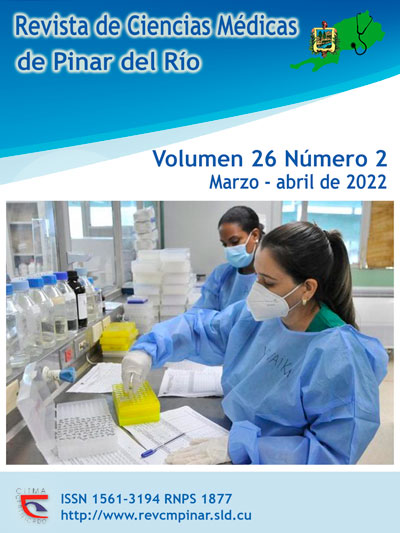Information architecture of the linear registry of pregnant women and newborn in the municipal department of Genetics, Pinar del Rio
Keywords:
GENETICS, MEDICAL, INFORMATION ARCHITECTURE, PREGNANT.Abstract
Introduction: information and communication technologies (ICT) have been rapidly increasing. They are currently producing a thoughtful technological revolution. As part of this computerization of Cuban society, public health does not escape from it and is one of the sectors in some way favored by the impacts of ICT, projecting an even greater process of computerization of the National Health System, where Genetics is one of the specialties that should serve as an entryway.
Objective: to develop the Architecture for the management of the information of the linear registry of pregnant women and newborns in the municipal genetics department of Pinar del Rio.
Methods: a Technological Innovation Research is carried out on the information management of the linear registry of pregnant women and newborn under study, following the methodology of software development for Extreme Programming, applying theoretical and empirical methods for the analysis, review and modeling of the processes to be computerized.
Results: it was evaluated that the informatics proposal is based on managing the linear registry information, serving as a tool to help organize the processes developed in the area with the pregnant woman and the newborn.
Conclusions: a prototype was developed for the architecture of the linear registry for pregnant women, which will visualize everything related to the pregnant woman who periodically has to be assessed at the genetics office with her respective complementary and diagnostic tests.
Downloads
References
1. Manson M. Evolución de la informática en el desarrollo social. [Internet]. Monografías; 2017 [Citado 16/04/2021]; Disponible en: https://www.monografias.com/trabajos/evoinfosoc/evoinfosoc
2. Martínez Abreu J, de León Rosales LC, García Herrera A L, Betancourt Pérez-Carrión N. Desarrollo de la informatización en la Universidad de Ciencias Médicas de Matanzas. Rev. Med. Electrón. [Internet]. 2018 Dic [Citado 16/04/2021]; 40(6): 1724-1728. Disponible en: http://scieloprueba.sld.cu/scielo.php?script=sci_arttext&pid=S1684-18242018000601724&lng=es.
3. Pérez Martinot M. Uso actual de las tecnologías de información y comunicación en la educación médica. Rev Med Hered [Internet]. 2017 [Citado 16/04/2021]; 28(4): 258-265. Disponible en: http://www.scielo.org.pe/scielo.php?script=sci_arttext&pid=S1018-130X2017000400008&lng=es. http://dx.doi.org/https://doi.org/10.20453/rmh.v28i4.3227.
4. Ponjuán Dante G, Hernández Castellano W. Contextos para la Gestión del Conocimiento en organizaciones cubanas: un acercamiento al "Ba" en Cuba. Rev Cubana Inf Cienc Salud [Internet]. 2017 [Citado 16/04/2021]; 28(2): 1-17. Disponible en: https://www.medigraphic.com/pdfs/acimed/aci-2017/aci172d.pdf
5. Pérez García R. Impacto de la Informatización en la Sociedad Cubana. Ciencia, tecnología y sociedad. [Internet]. Universidad de las Ciencias Informáticas. Ciudad de la Habana; 20 de Abril del 2005 [Citado 16/04/2021]; Disponible en: https://www.monografias.com/trabajos24/informatizacion-cuba/informatizacion-cuba.shtml
6. Ramírez Monzón R. Aplicación Web para gestión comunitaria de personas con discapacidad, Departamento Relaciones Internacionales. Pinar del Río. [Internet]. III Jornada Nacional Virtual de Ciencias de la Información: Dirección Provincial de Salud; 2016. [Citado 16/04/2021]; Disponible en: http://jornada2011.sld.cu/index.php/jornada/2011/paper/view/11/71
7. Méndez Ortiz L, Cruz Landa AJ, Galindo Parra NJ. GESTIÓN DEL CONOCIMIENTO Y LAS TIC’S. Revista: Atlante: Cuadernos de Educación y Desarrollo [Internet]. 2018. [Citado 16/04/2021];
Disponible en: https://www.eumed.net/rev/atlante/2018/11/gestion-conocimiento-tics.html
8. García Garcés H, Navarro Aguirre L, López Pérez M, Rodríguez Orizondo MF. Tecnologías de la Información y la Comunicación en salud y educación médica. Rev Edu Med [Internet]. 2017 [Citado 16/04/2021]; 6(1). Disponible en: http://scielo.sld.cu/pdf/edu/v6n1/edu18114.pdf
9. González Rodríguez R, Cardentey García J. Las tecnologías de la información y las comunicaciones en la Atención Primaria de Salud. RevHab de CiencMéd [Internet]. 2016 [Citado 16/04/2021]; 15(4): 670-673. Disponible en: http://scielo.sld.cu/pdf/rhcm/v15n4/rhcm17416.pdf
10. Macías Rivera Y. Informatización: reto de la sociedad cubana actual. [Internet]. CITMATEL; 2020 [Citado 16/04/2021]; Disponible en: http://www.citmatel.cu/noticias/informatizacion-reto-de-la-sociedad-cubana-actual
11. Rivero Pino R. La promoción-prevención con enfoque comunitario en salud genética. Resultados sobre su divulgación en Cuba. Rev Cub de Gene Comu. [Internet]. 2017 [Citado 16/04/2021]; 11(2): 31. Disponible en: http://www.revgenetica.sld.cu/index.php/gen/article/view/35
12. Proenza Rodríguez R. Estrategia de superación para la prevención del riesgo genético en la comunidad dirigida a profesionales de enfermería [Internet]. Convención Tecno Salud. Camagüey;2016 [Citado 16/04/2021]. Disponible en: http://www.tecnosalud2016.sld.cu/index.php/tecnosalud/2016/schedConf/presentations
13. Pérez Herrera M, Orive Rodríguez NM, Pérez Urquiza R, Serrano Barrera OR. Promoción y educación para la salud genética. Resultados y proyecciones en la provincia Las Tunas. Rev Cub de Gene Comun [Internet]. 2013 [Citado 16/04/2021]; 7(2):12-8. Disponible en: https://www.medigraphic.com/cgi-bin/new/resumen.cgi?IDARTICULO=53340
14. Rivero Pino R. Promoción y prevención en salud aplicados a la genética. Rev Cubana de Genética Comunitaria [Internet]. 2018 [Citado 16/04/2021]; 12(2): 1-18. Disponible en: https://www.medigraphic.com/pdfs/revcubgencom/cgc-2018/cgc182e.pdf
15. Joseph Samarth D, González Yudiel la R, Molina de Armas E, Sánchez Perodin Y, Ibarrola Suarez R. Sistema Informático de Genética Médica [Internet]. 2014 Dic [Citado 16/04/2021]; 6(2): 195-206. Disponible en: http://scielo.sld.cu/scielo.php?script=sci_arttext&pid=S1684-18592014000200008&Ing=es.
Downloads
Published
How to Cite
Issue
Section
License
Authors who have publications with this journal agree to the following terms: Authors will retain their copyrights and grant the journal the right of first publication of their work, which will be publication of their work, which will be simultaneously subject to the Creative Commons Attribution License (CC-BY-NC 4.0) that allows third parties to share the work as long as its author and first publication in this journal are indicated.
Authors may adopt other non-exclusive license agreements for distribution of the published version of the work (e.g.: deposit it in an institutional telematic archive or publish it in a volume). Likewise, and according to the recommendations of the Medical Sciences Editorial (ECIMED), authors must declare in each article their contribution according to the CRediT taxonomy (contributor roles). This taxonomy includes 14 roles, which can be used to represent the tasks typically performed by contributors in scientific academic production. It should be consulted in monograph) whenever initial publication in this journal is indicated. Authors are allowed and encouraged to disseminate their work through the Internet (e.g., in institutional telematic archives or on their web page) before and during the submission process, which may produce interesting exchanges and increase citations of the published work. (See The effect of open access). https://casrai.org/credit/



